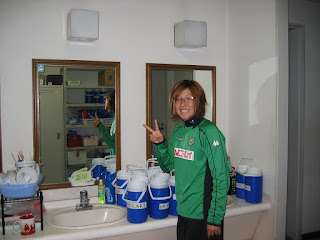


What does Japanese soccer practice look like? It's hard to explain. We do something different every day. We play possession. We play small-sided. We have shooting practice. We do everything we do in the US, yet somehow, it's all different. There are rules, boundaries, restrictions, and multiple ways to score goals. There is something to think about at all times, but one thing there isn't - touch restrictions. It's always unlimited touches, what they call "free". Creative freedom is encouraged and rewarded. Aggressive defense is constant. A player is always under pressure from multiple defenders at the same time. When she can escape the pressure, she is applauded. As a result, rushing with the ball, forced passes, and predictability are rarities. In their own words: craft, out-maneuvering, and explosion are three keys to Japanese style soccer.
The players here are also the most industrious and hard working I've ever seen. Standing around and laziness are non-existent. No one takes a day off. This attitude is reflected in the way they train. For instance, practice doesn't officially start until 6:30 pm, but everyone is on the field preparing and warming up by 6:00. Many of the younger players come early to join the youth practice at 5:15, jumping straight into our practice directly afterward. Training sessions are scheduled to end at 8:00 pm, but that has only happened once since I've been here.
Even when the coach, Mr. Hoshikawa, blows his whistle and practice is over, it's still not over. Each player has individual goals, and after practice is her time to work on them. Extra training is not mandatory or monitored, but everyone subscribes to it. You will find players working on everything from shooting, passing, and juggling, to fitness, long balls, and any other skill you can think of. Only after each player finishes her individual training does she head to the locker room for a shower and medical treatment. The last player rarely walks off the field before 9:00 pm. It is no wonder Japanese players exhibit such a high level of mastery. Their work is never done.
September 18th. Friday was not a typical practice, but it wasn't all that different either. I finally walked off the field around 8:45, and that's only because we were in a rush. Having warmed up at 6:00pm, watched film at 6:30, practiced at 7:15, and scrimmaged at 8:00, we were now rushing to catch the bus, to catch the train, to catch some of Sawa's friends in the international district called Roppongi. Otherwise, we may have been on the field for another half an hour as is customary.
Once a week, in the middle of every week, the team starts practice by watching film from the game the week before. The first week, Jo and I sat in on the meeting. The coach doesn't speak much English, so all coaching points were made in Japanese. All written materials and subtitles were in Japanese. Needless to say, we didn't understand much. This week, Mr. Hoshikawa added English subtitles to help us learn what the team was learning. We were very grateful. There was just problem...
Japanese doesn't translate directly to English, and the opposite is also true. So, as the film played, and English subtitles flashed across the screen we looked at each other perplexed. It was still like we were reading another language. Words were in the reverse order, verbs coming at the very end of the sentence, confusing in our minds who was taking what action and when. The choice of words was like none I've ever heard used in soccer before. We were still completely lost. Each time the English flashed across the screen we could do nothing but laugh. We were rendered incompetent in our own language.
After the film session we went to practice and went back to everything being in Japanese. We were again lost, but it was comforting to be lost in a foreign language and not our own. As is customary on film days, practice ends with a 45 minute scrimmage. The team was divided into an 'A' and 'B' team. The 'A' team, the starting 11 for Beleza, consisted of: Washington Freedom star Homare Sawa, Japanese international Shinobu Ohno (drafted to the Boston Breakers, 2009), five other current Japanese national team players (Kinga, Naga, Asano, Iwashi, Toyoda - mostly nicknames), a few former national team players, and is rounded out by a couple of young national team hopefuls / youth national team standouts.
The 'B' team, far younger on average (except for us), included: Jo, myself, two youth team coaches, and FC Gold Pride's Eriko Arakawa (nickname, Gan-Chan, she is just returning from a hamstring injury). We were a hodgepodge team, but proper technique and tactics are ingrained in every Japanese player at a young age, so our performance was almost seamless. This week we beat the super star 'A' team, avenging our loss from the week before thanks to goals from Arakawa and Jo. We were out-played for a lot of the game, but the 2-1 was an accomplishment none-the-less.
The mid-week scrimmage is the only time other than game day that the team plays on a full size field. The rest of the week we train in tight spaces, and tight may be an understatement. When we play 9 v. 9 or 10 v. 10, we play on less than half the field. The players are so technical they don't need anymore space. However, the mid-week scrimmage on the big field is special, and something the players look forward to. It is taken very seriously, and Joanna and I can feel its importance. We consider ourselves very lucky to be a part of this training environment, and honored to have escaped with a win this week.
No comments:
Post a Comment